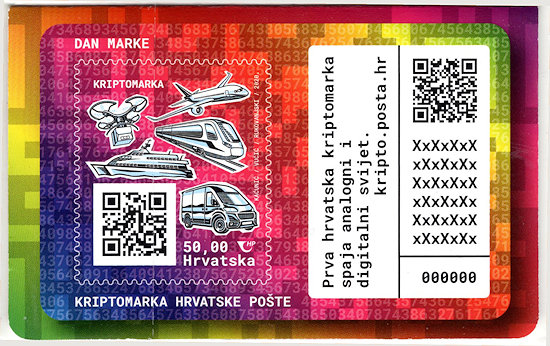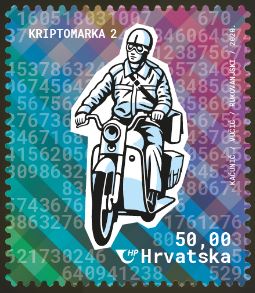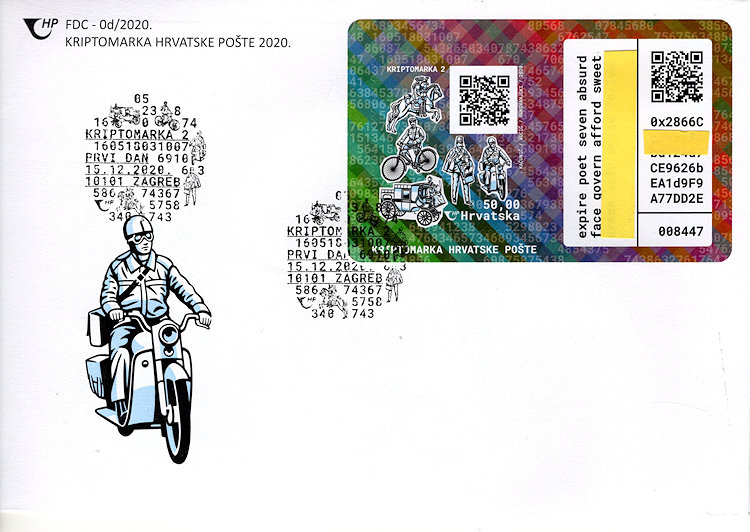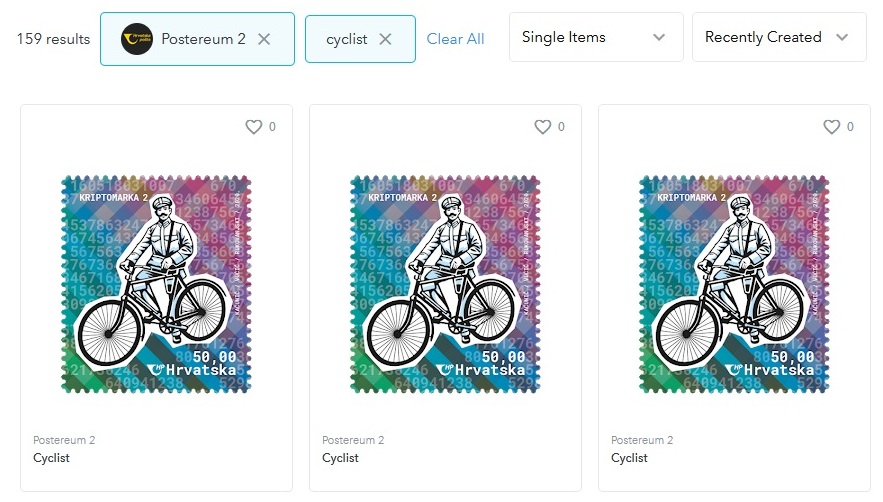Crypto stamps!
Crypto stamps?
Now, what is this? Never heard of it? That's very well possible because it is a new form of stamps. Some explanation is needed here, it is not possible to illustrate it with a simple picture. It is about the digital world, the world of data, as are recorded and stored with the help of computers.
In first instance, it is nothing more than replacing paper records and archiving. Think of the doctor. In the past, every general practioner had a patient card for each patient. It contained your medical history, and on a subsequent visit he added the new complaints, treatment and prescription. Nowadays the same data is stored on the computer and the doctor looks at his screen during a visit. The data reside on the computer where, unless you (accidentally) delete them, they won't disappear.
Nowadays there are also things that only exist digitally and no longer refer to something concrete. An example of this is a musician who records his music digitally and only distributes it digitally. There are no more records or CDs of it. Another example is the writer who types his book on the computer and only distributes it as e-books. There is no longer a physical book you can hold.
A crypto stamp is a stamp that connects the analog (physical) and digital (computer) world. It consists of two parts: a regular physical stamp and a digital part. You can use the physical stamp to send mail, just like any other stamp.
The digital part is nothing more than a secret string of numbers or characters that (with encryption) is stored on the computer and kept in blockchains.
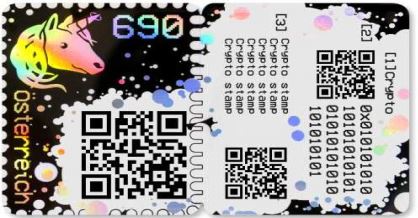
The physical part of a crypto stamp from Austria
Why crypto currency or stamps
Before there were banks, transactions were settled in cash. Due to the increasing transactions you had to carry more and more money with you. There was a solution for that: banks. You parked your money there for a small fee, and in a transaction ordered the bank to transfer money to the beneficiary. That seemed safe. Banks are reliable. Until the financial crisis in 2008. Some very large banks collapsed and many people lost their money. They would have wished it had been stored in an old sock. Is that still possible now that all your money is in a bank and payments are digital?
The development of computer technology made it possible to create a digital sock in which you can manage your money yourself and pay others directly, without the intervention of a bank. Blockchain makes it possible to purchase digital money (see it as a new country with its own currency system, for example Bitcoin), to store it in your own digital wallet and pay directly to other people who also have their own digital wallet, without intervention of other persons or institutions. Safe and anonymous, because only you and the recipient know about the payment.
For more info about blockchain see: https://en.wikipedia.org/wiki/Blockchain
How did I get to crypto stamps?
As motorcycle stamp collector I saw an offer of a Croatian stamp (?) with an image of, among other things, a moped or light motorcycle. And this would fit perfectly in my collection.
Most advertisements headed "motorcycle crypto stamp Croatia 2020 Crypto Stamp 2 M / S MNH", suggesting that there must also have been a first crypto stamp. Indeed, on September 9, 2020 a crypto stamp "Transport" was issued with images of a drone, plane, train, boat and bus. The sales value is 50.00 Croatian Kuna, approximately 6.60 euros.
The second crypto stamp was issued by the Croatian Post on December 15, 2020. The issue of this stamp highlights various modes of postal transport, which were selected for their importance in the shipment of postal items throughout history. In total, the issue consists of 30,000 stamps, which are divided into five different categories:
- Stagecoach for passengers, baggage and mail in Dalmatia, number of stamps 3000 (100)
- Austrian postillion, around 1730, number of stamps 4000 (150)
- Telegram deliverer on bicycle in Zagreb, number of stamps 6000 (200)
- Postman on moped in Zagreb 1960, number of stamps 8000(250)
- Austro-Hungarian postman 1900, number of stamps 9000 (300)
The number in brackets is the number of stamps of the category that can only be purchased with crypto currency. These stamps from the five different categories can only be viewed virtually, on a computer or smartphone.
Parts of the crypto stamp:
- A QR code that links to the overview page of crypto stamps from Croatian Post, showing all details and values of the virtual stamp.
- A physical stamp worth HRK 50 that can be used to pay for postage.
- A phrase made up of 12 words used to access your Blockchain wallet, so keep it safe! You must enter your private key IF and WHEN you decide to transfer your virtual stamp to another Ethereum address.
- The stamp serial number (a 5 digit number) used to view your virtual stamp by entering the number or scanning the QR code (also indicates which category is associated with the stamps).
- (Public) Ethereum address where the stamp has originally been stored.
- A QR code that links to the webpage which shows the owner of the stamp and his history.
New in this second series!
There is a surprise with this issue. Each virtual category has its own exclusive gold-plated version. Only five of the 30,000 are linked to a gold-plated version! By purchasing a crypto stamp through the Croatian Post internet shop or at any of the major post offices, you can become the proud owner of a gold-plated virtual stamp!
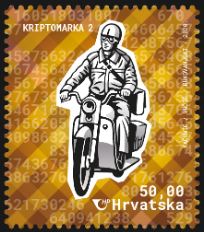 The gold-plate virtual motorcycle stamp
The gold-plate virtual motorcycle stamp
Only the category 4 stamp is important for our collection area.
The physical stamp (analogous part) of the crypto stamp always contains the image of all five postal delivery methods. This part can be removed from the carrier and stuck on a letter for postage. The crypto stamp is linked by a serial number to a virtual stamp from one of the five categories.
 The physical crypto stamp with the QR code
The physical crypto stamp with the QR code
Mailman on a moped in Zagreb, 1960 (category 4):
The motorization of postal transport in Croatia began in the 10s of the last century, a decade after the first cars arrived in Croatia. Road transport has given postal traffic a new quality, especially when it comes to the speed and safety of the transport of mail, but also of passengers. The modernization of the postal delivery service was later continued with the introduction of motorcycles, which were to complement the bicycles upon delivery. On a moped like this from the 1960s, the postman would deliver urgent mail for several decades.
From this category there are, as mentioned, 8000 crypto stamps to be sold, of which 250 can be bought with crypto currency (for instance bitcoin).
Furthermore, the crypto stamp contains various codes. With the serial number (4) at the bottom right you can see which of the five categories is associated with this specific crypto stamp.
My crypto stamp from the first series (transport) has number 030844 and appears to be from the category train. The crypto stamp from the second series (postal transport) has number 008974 and appears to be from the moped category.
How to check this: on your computer. Go to the website: https://kripto.posta.hr/marka/v2/wallet/
There you will see the following screen:
In the upper right corner choose for EN (English) and scroll down until you see the white space under the text "view a wallet", and fill in the serial number 008974 there.
After that click on the looking-glass icon, and then you will see:
When you are on the webpage of the 2nd series and type in a serial number of the 1st series, an error message will appear telling you that the serial number is not correct. In that case you must go back to the page of the 1st series, via the link "Go To V1" in the top part of the screen, and there give in the serial number (30844) and after that the image with the stamp will appear.
It can also be done by smart-phone. Scan the QR code of the stamp or the card:
Next you will see the image of the stamp on your telephone:
Private individuals have also made FDC's from the already limited issue of physical crypto stamps. The Croatian Post did provide a kind of First Day cancellation postmark for this purpose. The FDC's come in two types. The first type consists of FDC's with only the crypto stamp. The second type contains the entire face of the crypto stamp, including all virtual codes.
The latter has far-reaching consequences. With both types of FDC's you can view the virtual stamp using the QR code. Only with the second type, because the codes are present on the stamp, you can add the virtual stamp to your virtual wallet. Unless the sender has already done this and you are therefore too late.
Of the 30,000 crypto stamps, a number have been used to send letters. Again there are copies with the separate physical stamps and copies with the entire front of the carrier, so again with all digital codes.
 On top a letter with only the physical stamp and below a letter with the complete front.
On top a letter with only the physical stamp and below a letter with the complete front.
Although the owner of both letters has agreed to include them in his article
I still have protected the digital codes that give access to the website and wallet (bottom letter).
You can therefore include this virtual stamp in your own virtual (crypto) wallet. To do this, you have to create a wallet first, after which you can exclusively include the stamp in your wallet and thus create the beginning of your own virtual stamp album. But there are some practical objections to this, see conclusion.
According to the Croatian Post: Postereum 2 can last forever on the Ethereum blockchain and has collectible value, achieving a faithful translation of philately into the digital world.
Is the Croatian Post the only postal service that ventures on crypto stamps?
Before the Croatian Post started issuing crypto stamps, Austria was already ahead of them. Afterwards there were also crypto stamps from Gibraltar and the United Nations (UNO).
This is the physical stamp from Austria:
These are the digital versions (5 colours):
The stamp from Gibraltar:
and the one from the United Nations:
Conclusion
The answer to the question at the beginning of this article is my privrate opinion: I think the crypto stamp is a hype and it has no future. I will come back to that later.
Does this mean it is just a way for the various postal services to earn money? It seems very plausible given the (limited) number of stamps that are issued. Also the way in which the Austrian postal service organized the virtual sale of part of the issue (500 copies). The first 401 virtual stamps were sold at face value at the OnChain store. Purchase was only possible with crypto currency. The last 99 virtual stamps were sold in such a way that after each purchase of one or more stamp(s), the selling price increased by 8%. Theoretically, the last stamp would then be sold for 13,012.99 euros. That seems an easy way to make money.
The crypto stamps of Croatia are sold in (tightly sealed) plastic so that the link with a digital stamp is only known after purchase. That seems a bit like a lottery. In order to obtain the correct motif or a complete set (maximum 3000 as this is the smallest number issued, of the stamp with motif stagecoach) collectors are forced to purchase multiple crypto stamps. There is no effort on the part of the Croatian post in return. The same goes for the Austrian and UNO crypto stamps.
Yet my idea is that the Post Office did not choose this because it's easy earning money. The crypto world that runs on Blockchain technology is eagerly looking for possible applications for this new technology. To this end, various projects are started from the crypto world to investigate whether blockchain is the solution for this. The postal services are urged to set up such a "test project".
So why should crypto stamps be a hype and not a keeper?
If you dive a little deeper into blockchain technology, it turns out that around 200 billion has been spent worldwide since its design and installation and to date the crypto currency is the only thing it has yielded. And that is not easy either. Criminals who hack files, make them inaccessible for their owners, and demand payment in bitcoins as a ransom to release the files. These payments are so difficult that a manual is often included.
Blockchain technology concerns the way in which the data is stored. The data is not stored in one place, but each participant receives a copy. Those copies are all identical. New transactions are bundled in new blocks. The participant who solves a mathematical riddle on his computer is the owner of that block. This requires an enormous computer capacity and a lot of electrical power. There are estimates that the total amount of power required for "bitcoin mining" (creating new blocks) is equal to the annual power consumption of a household in Ireland or Austria. The person who is ultimately allowed to create the block receives a fee for this.
When a new block of data is finally created, each copy of the blockchain must decide whether the new block meets the conditions. Only when approved for this the new block will be added and all copies will be updated. All together a time consuming process. Only 75 transactions are executed per minute. Those transactions cost 1000 times more energy than transactions on traditional systems. For comparison, credit card organization Visa executes 56,000 transactions per minute.
Summarizing:
Blockchain is expensive (energy costs), requires a lot of struggle in mathematical riddles (which are becoming increasingly difficult) and is very slow.
In addition, the democratic premise, that nobody owns the data because all copy holders are together, is not very appropriate if it turns out that a few users own many blocks in the blockchain. This creates a new elite, which is often anonymous, making it difficult to find out who is responsible in the event of imperfections (such as emptying a wallet or failing transactions). Blockchain specialists are not covered by the current structures, so protection against illegal practices is minimal.
In my opinion, all this ensures that if the blockchain technology does not improve significantly, there is no future. The numbers of crypto stamps will then remain limited.
But.... if a crypto stamp is issued that fits in a thematic collection and is reasonably priced, I would buy it. Nice addition.
And I am convinced that this is one of the few ways to include a QR code in an exhibition collection. This code is in current collections mainly used to show a video, picture or photo, for non-philatelic material or extra text to explain a philatelic aspect, or in case of too much text for an item. The QR code on the physical crypto stamp refers to a virtual stamp that is only stored in a virtual stamp album. This appears to be a postal application that justifies the inclusion of the QR code.
Remarks, comments or additions are very welcome.
Nico Helling
Thanks to:
Zoran Vlahovic, specialist on Croatian stamps
Hans de Kloet
Sources:
https://kripto.posta.hr/marka/v2/
https://crypto.post.at/
https://crypto.unstamps.org/
https://www.linns.com/news/world-stamps-postal-history/austria-s-crypto-stamp-2.0-to-be-issued-june-25
https://www.consumentenbond.nl/veilig-internetten/blockchain
https://de.wikipedia.org/wiki/Crypto_Stamp
https://www.postzegelblog.nl/tag/crypto-zegel/
https://www.printpakt.nl/blockchain-postzegel-primeur-voor-oostenrijkse-post/
About the disadvantages of blockchain technology:
https://decorrespondent.nl/8628/de-blockchain-een-oplossing-voor-bijna-niets/519071687772-2a5ee060
https://www.frankwatching.com/archive/2018/10/31/blockchain-is-niet-levensvatbaar/
Author: Nico Helling contact: This email address is being protected from spambots. You need JavaScript enabled to view it.
References/External links:
This article was originally published in the newsletter no. 135 of The Dutch Motorcycle Philatelists Club MFN (Motor Filatelisten Nederland) in March 2021: Cryptopostzegels!
If interested in buying a virtual stamp with the cycling postman go to OpenSea the largest digital marketplace for crypto collectibles. Here is a selection:
You prefer the unique golden version (only 1 item issued)?  No problem: Just click and pay with your Ethereum wallet – it costs 30 ETH (= $80 000 on 5th June 2021).
No problem: Just click and pay with your Ethereum wallet – it costs 30 ETH (= $80 000 on 5th June 2021).




